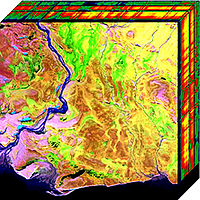
Photo from wikipedia
High cycle fatigue has been known as an important form of aeroengine blade failure. This study aims to achieve a method of investigation for a rotating blade vibration measurement, combining… Click to show full abstract
High cycle fatigue has been known as an important form of aeroengine blade failure. This study aims to achieve a method of investigation for a rotating blade vibration measurement, combining the two non-contact optical techniques of digital image correlation (DIC) and blade tip-timing (BTT). Dynamic parameters of a thin-blade were obtained on a stationary vibration platform with stereo-DIC system. Meanwhile, the finite element analysis (FEA) of this thin-blade was performed within different rotating speeds. Then, the set of thin-blades was mounted in a simulated compressor test rig equipped with BTT and a wireless strain gauge (SG) system. A rotor speed sweep experiment was carried out and the blade synchronous resonance parameters were extracted. Results show that the displacement mode shapes match well between DIC and FEA, and that MAC values of the first six order modes are over than 0.88. The predicting strain from the FE model and SG agreed to within 32.41% in the worst case, and the predicting strain from the DIC model corresponds to 28.53% in the worst case. This is an effective non-contact, high-precision full-field deformation measurement method that is worth exploring for structural design and dynamic strain assessment of vibrating components.
Journal Title: Micromachines
Year Published: 2022
Link to full text (if available)
Share on Social Media: Sign Up to like & get
recommendations!